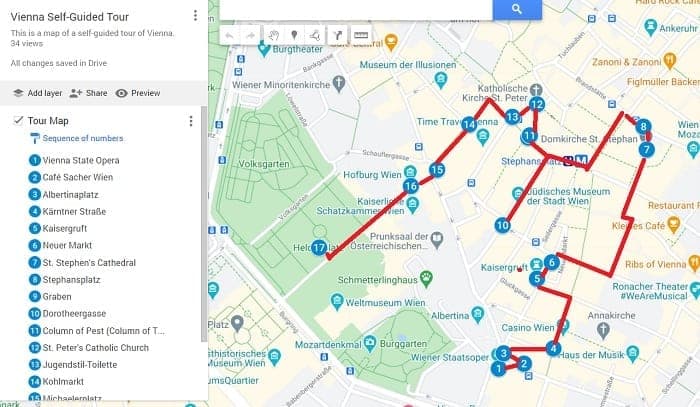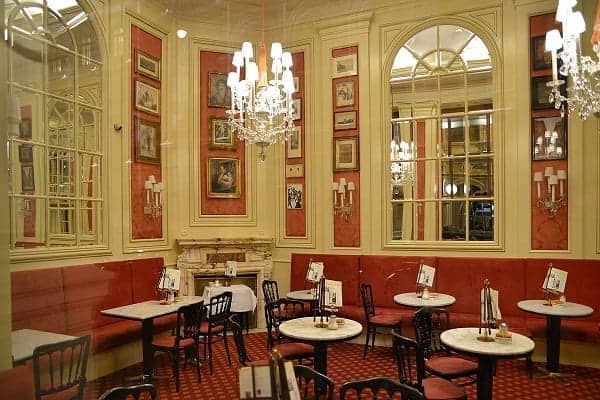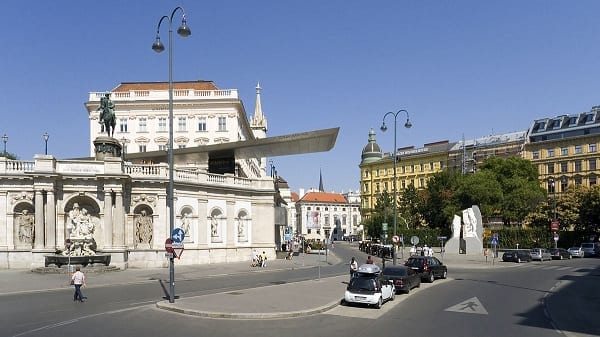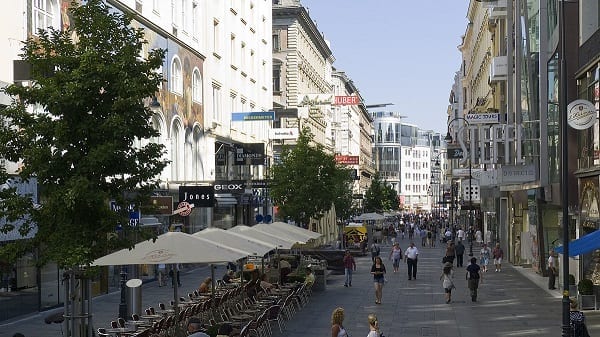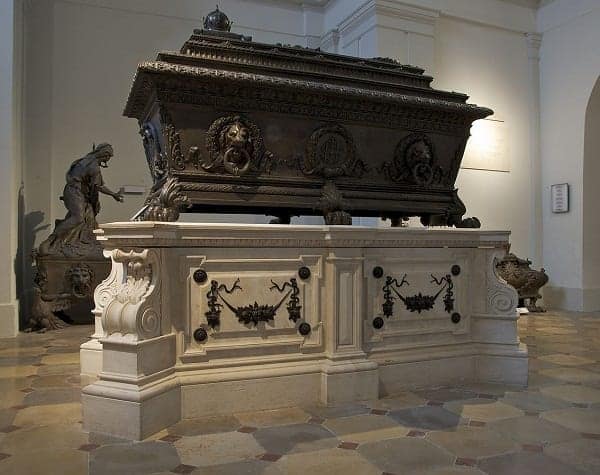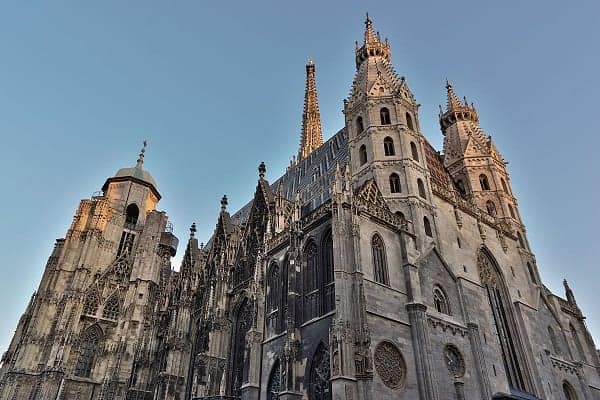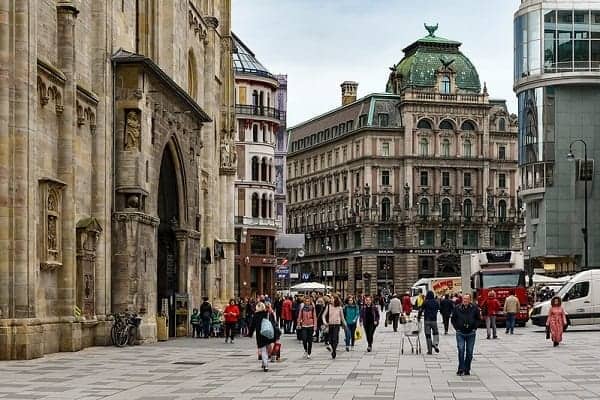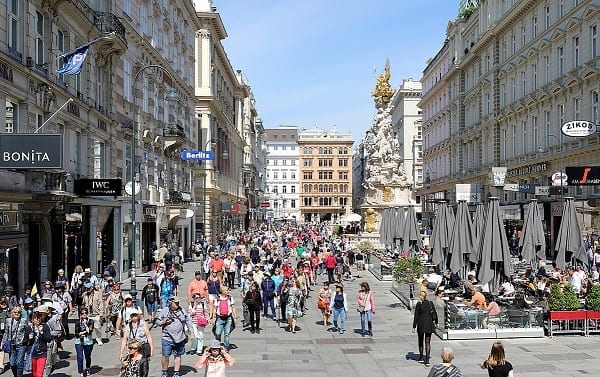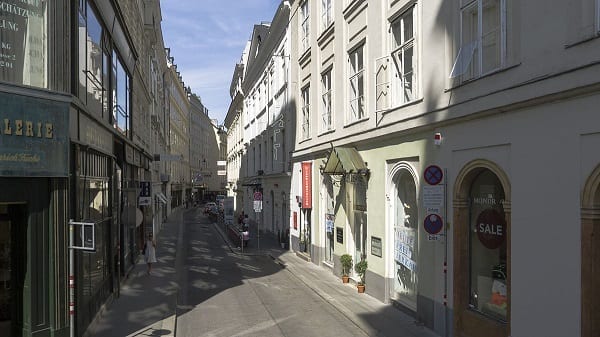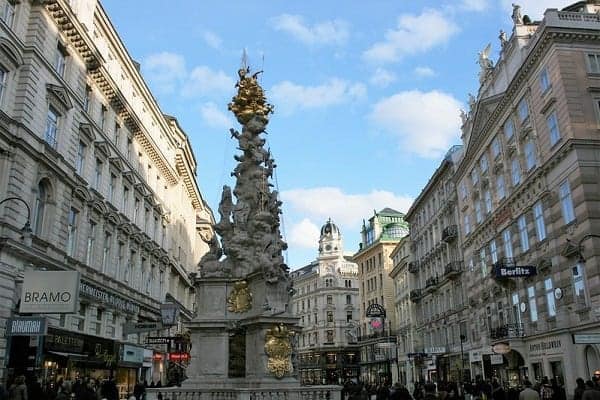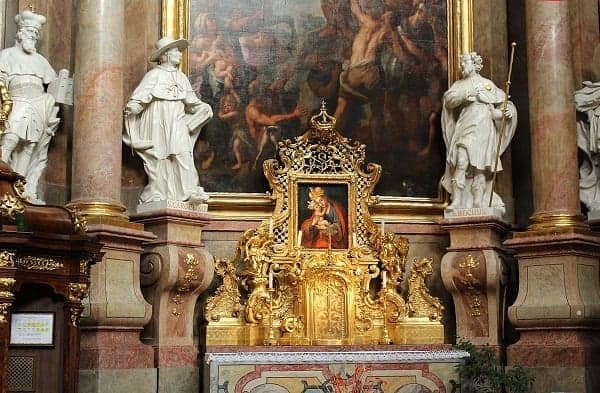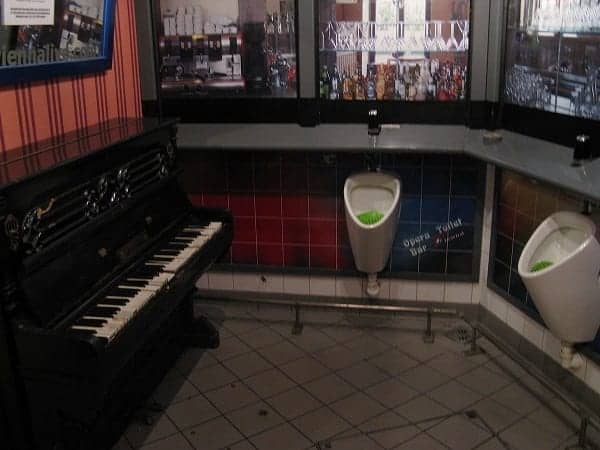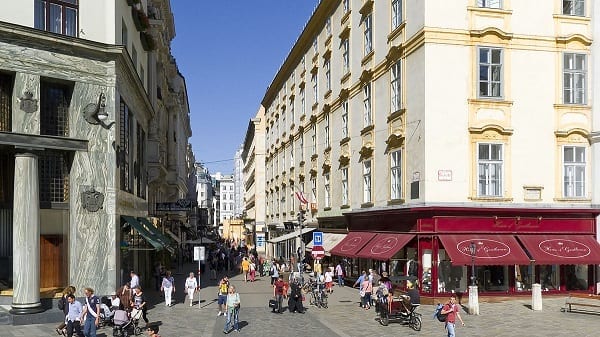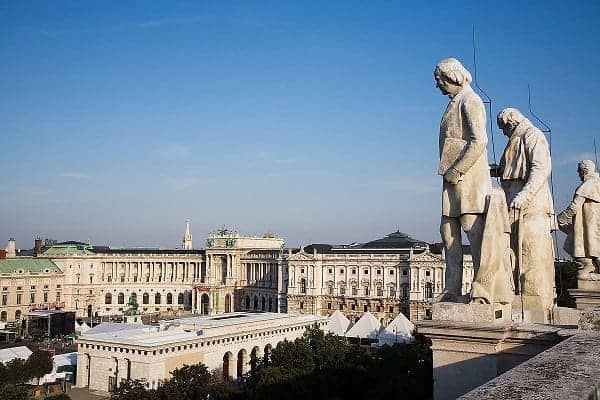This free, self-guided walking tour is a companion to a free audio tour of Vienna's historic center.
This tour will cover important information about several notable landmarks and locations in Vienna.
But, if you’re looking for an even more in-depth experience, consider downloading the audio tour as well.
SELF-GUIDED TOUR OF VIENNA
If you don't enter any buildings along the route, this tour takes approximately 60-75 min depending on your pace of walking.
We based this route on the free audio tour from Rick Steves. Our content is unique, but we recommend listening to his well-produced tour.
You can also download his free tour wherever you get podcasts or simply download his Audio Europe app.
He also offers several travel books for the city. Just check out Rick Steves Vienna on Amazon (Disclosure).
And be sure to check out our other free walking tours of Vienna.
Here is our main schedule. More tour options are available here.
Searching Availability...
Vienna State Opera
Built over a period of 8 years from 1861-1869, this Renaissance Revival venue has been hosting wonderful operas for over a century.
Originally, this location was known as the Vienna Court Opera, but following the formation of the First Austrian Republic in 1921, they adopted its current name.
This is also the home of both the Vienna Philharmonic and the Vienna State Ballet. During Carnival, the Vienna Opera Ball is hosted here.
Although the Vienna State Opera was set ablaze by an American bombardment during WW2, it would later be restored and reopened in 1955.
This is one of the busiest opera houses in the world, producing 50+ operas and ten ballet productions for a grand total of 350 or more total performances -- almost one per day!
Cafe Sacher
This cafe is the home of a famous cake known as the Sacher-Torte. The original cake was crafted in 1832 when Prince Metternich requested a dessert for a special occasion.
The chef was ill at the time, so he had his 16-year old apprentice Franz Sacher take over.
The result was a delicious cake which became a favorite in Vienna for years to come.
Over the years, locals have said that the quality of the cake decreased, but Cafe Sacher uses the same recipe to this day, so maybe it’s just the tastes that have changed?
Whatever the case may be, this would be a great place to stop in for a snack before continuing your tour.
Albertinaplatz
This public plaza is filled with interesting things to see and lined with several notable sites such as the Albertina museum, the Vienna State Opera House, Cafe Mozart, a Schanigarten and more.
There are also a lot of statues on Albertinaplatz, including the Monument Against War and Fascism, which addresses the history of the Nazi occupation in Vienna while speaking out against all forms of war.
The split white stone monument is called the Gates of Violence, and it symbolizes the gates of a concentration camp.
The statue with his head in stone is Orpheus, and he is a reminder of the dangers of ignoring the rise of fascism.
The figure hunched on the ground is a Jew being forced to scrub anti-Nazi propaganda off the street.
This monument is located on Albertinaplatz for good reason, as this is the site where bombs once struck during WW2 and buried hundreds of innocent people.
Karntner Strasse
This street is the old shopping district of Vienna, and it is lined with several interesting stores.
In addition to all the great shopping, you can also enjoy some people watching while you’re in the area.
Some of the stores in this area can be quite expensive, so unless you’ve got plenty of money to spend, we recommend taking a look around and enjoying the atmosphere.
There is also a free glass museum above the J&L Lobmeyr Crystal shop, and this could be a great location to visit if you’re looking for fun and affordable activities.
Kaisergruft
This historic church is the home of a crypt which houses the tombs of Hapsburg royalty, including both emperors and empresses.
The crypt is filled with free standing sarcophagi which each have incredibly ornate and detailed designs, including decorative sculptures, reliefs, engravings and more.
The Kaisergruft is open daily from 10 am - 18:00 (6 pm) and tickets are fairly affordable at €7.50 for adults and €4.50 for children and teenagers under the age of 18.
They also offer guided tours for an extra €3.50 per ticket.
Neuer Markt
Also known as the New Market, this public square is lined by notable buildings like the Kaisergruft and there is also a great attraction here as well.
The Four Rivers Fountain is located at the center of Neuer Markt, and it symbolizes the rivers that flow into the Danube. The fountain was designed by Georg Raphael Donner in 1739.
There are also a few notable hotels in the area including the Hotel Ambassador on the former site of the flour depot and Hotel Meissl & Schadn where Friedrich Adler shot Prime Minister Karl Stürgkh in 1916.
St. Stephen’s Cathedral
Built in 1160, this is the mother church or the Roman Catholic Archdiocese of Vienna.
It’s also the seat of the Archbishop of Vienna. This is arguably the most important religious building in the city.
As with most churches this old, it has seen a number of renovations over the years which have given it multiple different architectural styles including Romanesque and Gothic.
This has been the site of many historic moments, but one of the most notable events was when famed composer Ludwig van Beethoven discovered he was deaf as birds flew out of the bell tower.
In addition to the church, this is also the site of tombs, catacombs and crypts, including the tombs of Prince Eugene of Savoy and Emperor Frederick III.
Stephansplatz
This is the public square in front of St. Stephen’s Cathedral.
There are a few things of note to see in this area, including beautiful architecture and even a tree trunk from the middle ages.
The Stock im Eisen, also known as the Staff in Iron, is a section of a tree trunk which has been hammered with hundreds of nails over many centuries.
The earliest written mention of this attraction dates back to 1533.
If you look opposite from the cathedral, you’ll see the Haas-Huis, a unique house built in the postmodern architectural style by Hans Hollein in 1990.
Graben
This is one of the most notable streets in the city centre of Vienna, dating back to the 12th century and absolutely filled with interesting history.
Think of this as the main street of the city. It has been used in centuries past as both a marketplace and a site for festival processions.
The buildings in this area are mostly known for their owners.
The Freisingerhof is named after the See of Freising who owned it in the 12th century and used it as the administrative centre of his estates in Vienna.
The Ankerhaus, built in the 1890’s, was owned by Otto Wagner, who also built the Grabenhof in 1873 with Otto Thienemann.
This is also the site of the Palace of Barons Bartolotti bon Partenfeld, and it is the only remaining baroque structure on the Graben.
There are also two fountains here which feature sculptures of St. Joseph and Leopold, both of which were designed at the request of Leopold I.
Dorotheergasse
Named after the monastery of St. Dorothea, this narrow lane is part of the old town district in Vienna, and it’s also home to one of the oldest auction houses in the world, the Dorotheum.
This is also where you will find the Jewish Museum of Vienna, which tells the story of Jewish history and culture in Austria.
This museum was founded in 1896, so it was well established by the time Nazi Germany entered Vienna, and at that time its contents were distributed to other museums.
Eventually, the artifacts and exhibits which were taken from this location were returned to the Jewish community beginning in the 1950s.
Admission to this museum is free with the Vienna Pass.
The Plague Column
This Holy Trinity column was erected on the Graben after the Great Plague in 1679.
This is an example of the baroque style, and it’s one of the most well known sculptures in the city.
The top of the column is arguably one of the more ornate pieces on the structure, featuring dozens of angels, cherubs, baubles and of course a prominent cross being held out by a religious figure.
There is a lot of iconography all over the column, but the main message is that the plague was punishment for sin and it was stopped thanks to the piety and work of Leopold I.
Whether or not you believe Leopold’s faith was responsible for the end of the plague, this monument has an interesting mix of both religious icons and political propaganda which is definitely worth seeing up close.
St. Peter’s Church
This baroque Roman Catholic church was first built in the early middle ages, but nothing remains of the original building, and its most recent design was consecrated in 1733.
The concept for this church was inspired by St. Peter’s Basilica in Rome, which is one of the reasons why it also has a domed structure.
There are a lot of great things to see in the church, including the Coronation of Our Lady fresco, The Heart of Mary painting, and the beautiful baroque pulpit designed by Matthias Steinl, who also came up with the design for the dome.
Public WCs
If you need to take a break to use a restroom, there are actually some historic public toilets in the area which were not only designed to be very clean, but also quite beautiful.
These were once wine cellars, but they were turned into restrooms in the early 1900’s by a chemist who wanted to prove the effectiveness of his chemicals for cleaning.
The WCs were designed in the modernist style. Originally they had chandeliers for lighting, but they have since been removed.
That said, much of the modernist design remains, and this is still a great place to stop and take a break if you need one.
Kohlmarkt
This street runs from the end of Graben to Michaelerplatz, and there are at least a few notable shops you may want to visit while you’re in the area.
Of course, one of the first things you’ll notice is that Kohlmarkt is filled with upscale stores such as Armani, Tiffany, Gucci, and more.
Most tourists probably won’t want to stop in these locations, but if you’re looking for a treat, the Demel chocolate shop is halfway down the street.
This is one of the best places for chocolate in all of Vienna, and they have a lot of great sweets to purchase.
The former queen Sisi was said to have ordered her chocolates from Demel, and you may notice her image on a few different items in the shop.
Michaelerplatz
This is the site of the main entrance to the Hofburg Palace.
The square was named after St. Michael’s church, which is located right across the street.
They offer tours of the crypt of St. Michael’s which some might consider a bit creepy, as some of the corpses buried here are incredibly well preserved due to the climatic conditions and temperature of the location.
On the right-hand side of the church you’ll see Loden-Plankl, a 19th century shop where you can still find old-world apparel and traditional Austrian formal wear.
The street leading South from Michaelerplatz will take you back to Albertinaplatz, but there are still a few more stops to see before heading back.
The Hofburg Palace
Built in 1275, this is the official residence of the President of Austria, but it also houses several other noteworthy attractions you may want to visit.
Visitors will find a museum dedicated to the history of Queen Sisi, as well as a museum highlighting a collection of silver items.
The Hofburg Palace is open from 10 am - 17:00 (5 pm) most days, and tickets start at €15 for adults and €9 for children between the ages of 6 - 18.
If you’re interested in seeing more, there is also a museum dedicated to the Imperial Treasury of Vienna and you can also visit the Spanish Riding School to see a demonstration of equestrian art.
Admission to each of these attractions is included at no extra cost with the Vienna Pass.
Heldenplatz
This public square is located on the other side of the Hofburg Palace, and it was actually the site of at least a few notable moments in history.
The most infamous event that took place here was when Adolf Hitler made his announcement that Vienna had been annexed into Nazi Germany on March 15th, 1938.
There are also two equestrian statues in the plaza that you might want to see: one of Archduke Charles of Austria and another of Prince Eugene of Savoy.
This is also the side of the Burgot, a city gate dating back to the 1800’s.
On the left-hand side of the plaza, you’ll see the Neue Burg wing of the Hofburg Palace and the Papyrusmuseum.
On the Northern end of the plaza you’ll find the Volksgarten, which also has a rose garden that blooms quite beautifully in the summer.




